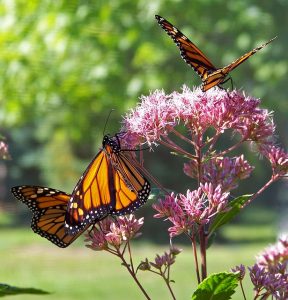Project acts on protecting Illinois’ monarchs
University of Illinois Extension — June 12, 2020
The Illinois Monarch Action plan addresses four sectors of land in Illinois: agriculture, urban, natural areas, and roadsides. (Photo courtesy of University of Illinois Extension
Each spring, Illinois honors the state insect, the Monarch Butterfly.
But, University of Illinois Extension Horticulture Educator Kelly Allsup says “Illinois residents should be worried about their state insect.” The yearly count of Monarchs decreased by 53 percent this past year. This most recent drop may not be directly correlated to our milkweed numbers, but possibly drought and other environmental factors. However, the decrease in the monarch population over time can be attributed to a lack of milkweed for larvae.
Monarchs will be considered for inclusion on the Endangered Species list in December 2020.
These numbers make state collaborations like the Illinois Monarch Action Plan that much more important for Illinoisans.
The Monarch Action plan addresses four sectors of land in Illinois: agriculture, urban, natural areas, and roadsides. Their goal is to plant 150 million new milkweed plants by 2038. Every stem will help. Austin Omar, associate director of Natural Resource Policy of the Illinois Farm Bureau, and leader of the agriculture sector committee says, “It is important that residents of Illinois document their monarch habitat through these programs so they can be counted.”
Successes of the program so far include:
• More than 80,000 acres of roadside habitat created by IDOT’s new mowing policy. They developed the Illinois Monarch Project (IMP) Mowing Guidance to aid farmers in roadside habitat creation.
• More than 100,000 acres enrolled in agriculture programs to establish pollinator habitats. The federal program CP42 allows landowners and farm operators to establish plots of diverse wildflowers and legumes vital for the longevity of pollinator species.
• Pheasants Forever supported 6,600 acres of pollinator habitat. Pheasants Forever is dedicated to the conservation of pheasants, quail, and other wildlife through habitat improvements, public awareness, education, and land management policies and programs. By establishing habitat for monarchs, they fulfill their mission of establishing habitat for pheasants and quail.
• The Field Museum in Chicago developed a series of urban habitat planning tools.
What can you do for our Monarchs?
• Participate in the I-Pollinate Citizen Scientist program, a research initiative through the University of Illinois. I-Pollinate enlists citizens to collect data on monarch egg and caterpillar abundance, pollinator visitation to ornamental flowers, and state bee demographics. (https://ipollinate.illinois.edu/)
• Plant a Pollinator Pocket garden that attracts and nurtures pollinators in your own yard. Visit the program’s website for guidance establishing and maintaining your new garden. (https://extension.illinois.edu/cfiv/pollinator-pockets)
• Register your garden with the Monarch Waystation to support monarch conservation. Your efforts will help assure the preservation of the species and the continuation of the spectacular monarch migration phenomenon. (https://monarchwatch.org/waystations/)
• Plant milkweed. If you plant a 10 square-foot garden of milkweed, about 150 stems, you would help Illinois do its part to conserve monarchs. Plant Ecologists whose research focuses on Monarchs at the Illinois Natural History Survey say that swamp milkweed (Asclepias incarnata) has been the most preferred milkweed species of Monarchs. Other preferred milkweed species gardeners can grow are Butterfly weed (Asclepias tuberosa), Common milkweed (Asclepias syriaca), Prairie milkweed (Asclepias sullivantii) and Whorled milkweed (Asclepias verticillata). Establish groupings of plants in full sun and eliminate pesticide use.
• Include nectar sources throughout the entire growing season.
Spring: Chives, Culver’s Root, Viburnum, High bush blueberry, and Amelanchier
Summer: Salvia, Coneflower, Prairie Blazing Star and Buttonbush
Fall: Monarda, Aster, Goldenrod, Sedum and Lead plant
Plant blooming annuals like Salvia, Zinnias, Cosmos, Lantana, Mexican Sunflower, and Lavender
Plant a ground cover of White Clover, Creeping Thyme or Buckwheat
• Save milkweed seed to share with others. In the fall, seed heads burst open into silky white fluff. To ensure maturity, pods should already have started to split open, or easily open when squeezed, and seeds should be dark in color.
Once pods have been allowed to dry, the seeds can be separated by holding one end and stripping the seeds away from the white fluffy floss with your fingers. Another method is to place the seeds in a paper bag with a coin. Cut a hole in the bottom of the bag so the seeds fall out after a good shaking.
• Teach children about the lifecycle of monarchs to develop their appreciation for nature. Dried pasta is a great representation of the stages when arranged on paper and labeled: orzo (egg), fusilli (larvae), shell (chrysalis), farfalle (adult).
University of Illinois Extension Youth Horticulture Educator, Brittnay Haag says, “Encourage kids to share what they have learned about monarchs with others. The more someone knows about something they can do to make a difference, the higher the chance they will support and protect the monarch butterfly.”
Every stem of milkweed and nectar garden planted contributes to the survival of the Monarchs but also many other wildlife including pollinators and birds.



